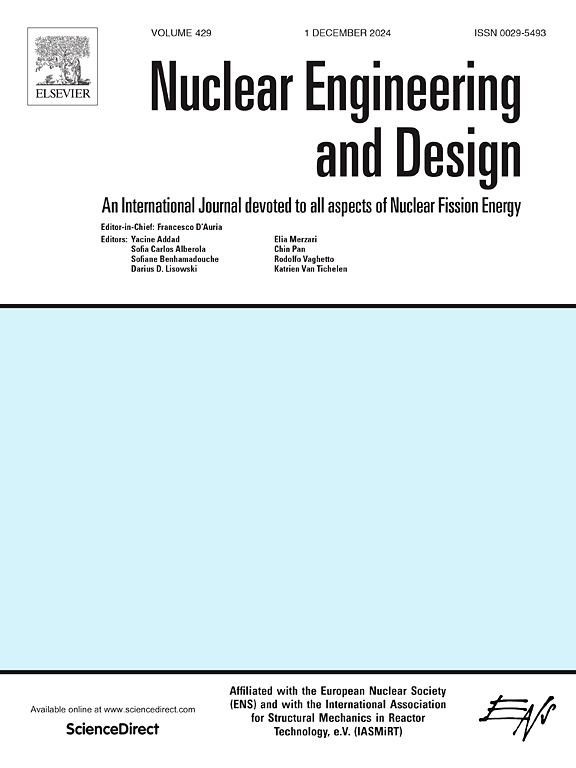High-resolution predictions of the coolant properties for the 3D PWR core with artificial neural networks based on CTF
IF 1.9
3区 工程技术
Q1 NUCLEAR SCIENCE & TECHNOLOGY
引用次数: 0
Abstract
PSI and North Carolina State University are developing a high-resolution multi-physics core solver for Pressurized Water Reactor (PWR) analysis in Cartesian geometry, using the neutron transport code nTRACER and two Machine Learning (ML) models providing thermal–hydraulic (T/H) feedback. This work focuses on the ML models, trained with CTF data to predict PWR subchannel coolant properties during normal operation. The methodology presented can be applied to different PWR core, to produce ML models capable of high-resolution T/H predictions. The ML model’s performance is evaluated on quarter-core CTF calculations achieving an average temperature difference of 1 °C from CTF and equivalent density accuracy. Their verification is extended outside configurations seen in their training, with varying mass flux, a water liner and different lattice geometry. They are also compared to a simplified one-dimensional T/H solver, showing significantly lower discrepancies, almost half, with similar computational cost, while being up to 15 times faster than CTF.
基于CTF的人工神经网络对3D压水堆堆芯冷却剂特性的高分辨率预测
PSI和北卡罗莱纳州立大学正在开发一种高分辨率的多物理场核心求解器,用于在笛卡尔几何中分析压水堆(PWR),使用中子输运代码nTRACER和两个提供热工(T/H)反馈的机器学习(ML)模型。这项工作的重点是ML模型,使用CTF数据进行训练,以预测正常运行时压水堆子通道冷却剂的特性。所提出的方法可以应用于不同的压水堆堆芯,以产生能够进行高分辨率T/H预测的ML模型。ML模型的性能通过四分之一核心CTF计算进行评估,CTF的平均温差为1°C,密度精度等效。他们的验证扩展到训练中看到的配置之外,具有不同的质量通量,水衬里和不同的晶格几何形状。它们还与简化的一维T/H求解器进行了比较,结果显示差异明显降低,几乎为一半,计算成本相似,同时速度比CTF快15倍。
本文章由计算机程序翻译,如有差异,请以英文原文为准。
求助全文
约1分钟内获得全文
求助全文
来源期刊

Nuclear Engineering and Design
工程技术-核科学技术
CiteScore
3.40
自引率
11.80%
发文量
377
审稿时长
5 months
期刊介绍:
Nuclear Engineering and Design covers the wide range of disciplines involved in the engineering, design, safety and construction of nuclear fission reactors. The Editors welcome papers both on applied and innovative aspects and developments in nuclear science and technology.
Fundamentals of Reactor Design include:
• Thermal-Hydraulics and Core Physics
• Safety Analysis, Risk Assessment (PSA)
• Structural and Mechanical Engineering
• Materials Science
• Fuel Behavior and Design
• Structural Plant Design
• Engineering of Reactor Components
• Experiments
Aspects beyond fundamentals of Reactor Design covered:
• Accident Mitigation Measures
• Reactor Control Systems
• Licensing Issues
• Safeguard Engineering
• Economy of Plants
• Reprocessing / Waste Disposal
• Applications of Nuclear Energy
• Maintenance
• Decommissioning
Papers on new reactor ideas and developments (Generation IV reactors) such as inherently safe modular HTRs, High Performance LWRs/HWRs and LMFBs/GFR will be considered; Actinide Burners, Accelerator Driven Systems, Energy Amplifiers and other special designs of power and research reactors and their applications are also encouraged.
 求助内容:
求助内容: 应助结果提醒方式:
应助结果提醒方式:


